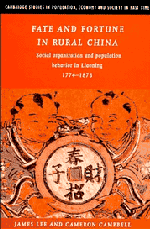Book contents
- Frontmatter
- Contents
- List of figures
- List of maps
- List of tables
- Acknowledgements
- PART 1 DAOYI VILLAGE
- PART 2 THE LIAONING DEMOGRAPHIC SYSTEM
- 4 Two types of positive check: infanticide and neglect
- 5 Two types of preventive check: nuptiality and fertility
- PART 3 HOUSEHOLD ORGANIZATION AND POPULATION BEHAVIOR
- PART 4 BANNER ORGANIZATION AND POPULATION BEHAVIOR
- EPILOGUE: PROSPECTS, IMPLICATIONS, AND COMPARISONS
- Appendices
- Glossary
- References
- Index
- Cambridge Studies in Population, Economy and Society in Past Time
4 - Two types of positive check: infanticide and neglect
Published online by Cambridge University Press: 20 October 2009
- Frontmatter
- Contents
- List of figures
- List of maps
- List of tables
- Acknowledgements
- PART 1 DAOYI VILLAGE
- PART 2 THE LIAONING DEMOGRAPHIC SYSTEM
- 4 Two types of positive check: infanticide and neglect
- 5 Two types of preventive check: nuptiality and fertility
- PART 3 HOUSEHOLD ORGANIZATION AND POPULATION BEHAVIOR
- PART 4 BANNER ORGANIZATION AND POPULATION BEHAVIOR
- EPILOGUE: PROSPECTS, IMPLICATIONS, AND COMPARISONS
- Appendices
- Glossary
- References
- Index
- Cambridge Studies in Population, Economy and Society in Past Time
Summary
The woman's position is usually inferior in the Manchu family and she is subjugated … The inferior position of the woman is especially accentuated in the order of taking and serving meals. The woman before eating is obliged to feed every day and in the first place the men, even if they be ordinary paid workmen or slaves. However … If the family is not very numerous, all the family members eat together.
(Shirokogoroff 1926, 126–127)We begin our discussion of the Liaoning demographic system with an analysis of mortality. The positive check does not fall equally on all segments of a population. Death rates vary by age and sex as well as time. Analysis of sex differentials in mortality rates reveals the effects of gender differentials on the allocation of resources, social roles, and the division of labor. Similarly, examination of age differentials in mortality rates may suggest the influence of age differentials in the allocation of resources, social roles, and the division of labor. The age and sex patterns of death, therefore, not only reconstruct the local mortality regime, something not yet done for late imperial China, but also provide insight into rural social organization.
This was especially true in rural Liaoning, as families influenced the survivorship of children, adults, and the aged through the widespread practice of conscious infanticide and unconscious neglect. We divide this chapter into four sections. In section I, we establish the broad parameters of mortality by calculating life tables by sex for the registered population, and then compare age-specific death rates with those in model life table families.
- Type
- Chapter
- Information
- Fate and Fortune in Rural ChinaSocial Organization and Population Behavior in Liaoning 1774–1873, pp. 58 - 82Publisher: Cambridge University PressPrint publication year: 1997



